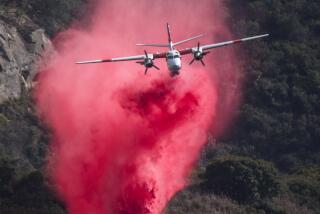Flying With a Twist
Looking for an unbeatable thrill? Want an adrenaline rush that won’t soon be forgotten?
Forget amusement parks and the promise of heart-stopping thrill rides. Instead, hop into an aerobatic plane--with an experience pilot at the controls. For as little as $100, a gut-wrenching experience can be had at Burbank and Van Nuys airports, where several aerobatic companies are based.
There are aerobatic maneuvers that have a pilot and his passenger pressed against the seat of the plane by positive gravitational forces, then floating off the seat due to negative Gs and back again to positive. All in a matter of seconds.
It’s no wonder aerobatic pilots often use the word addictive to describe what they do. The sensations and the speed are hard to beat.
Despite the excitement, aerobatic fliers are quick to point out that they are not daredevil stunt pilots. Every flight requires alertness, anticipation and preparation for an emergency.
The Plane
Cost: the airplanes sell new for between $80,000 and $265,000.
Safety Features: Aerobatic planes, certified by the FAA, are built to hold up under the stresses created by the maneuvers. They are also equipped with such safety features as breakaway canopies, detachable doors, and an extra durable, five-point harness system and safety belt.
Basic Moves
The maneuvers aerobatic pilots execute are virtually endless, limited in many ways only by the capabilities of the plane and a pilot’s imagination. Even so, every figure is essa variation of three basic maneuvers: the roll, the spin and the loop.
*
The Inside Loop: Also called the barnstormer’s loop, this maneuver is typically flown at about 140 to 180 mph.
*
The Spin: When an airplane approaches its stall speed, generally between 60 and 80 mph, a difference in lift between the wings cause it to spin. Spins can be initiated with the airplane upright or inverted.
*
The Roll: Rolls are completed at a rate of 180 degress per second to 500 degrees per second.
Competitive Flying
Precision is the key for competitive aerobatic fliers. The Wisconsin- based International Aerobatic Club sanctions all aerobatic competition in the United States. About 900 aerobatic pilots compete in one or more of the 40 IAC- sanctioned aerobatic competitions held in the U.S. each year.
*
Scoring: Contestants begin each sequence with a perfect 10, and points are taken away for mistakes.
*
The Box: A block of air 3,300 feet long and equally wide with a top 3,500 feet above the ground. The bottom of the aerobatic box varies with the competitive divisions. Pilots lose points for flying outside the box during a performance.
Level of Difficulty
* Basic / Sportsment class: Now lower than 1,500 feet.
* Intermediate: 1,200 feet.
* Advanced: 800 feet.
* Unlimited: as low as 328 feet.
For more information, call the Los Angeles Aerobatic Club: (3100 430-8306.
Sources: James Howell of Triacro Aviation; Dick Rihn and Sharon Heuer of the International Aerobatic Club; Randy Gagne of Attitude Adjusters Aerobatic Center; Researched by SHARON MOESER / For The Times
More to Read
Sign up for The Wild
We’ll help you find the best places to hike, bike and run, as well as the perfect silent spots for meditation and yoga.
You may occasionally receive promotional content from the Los Angeles Times.






